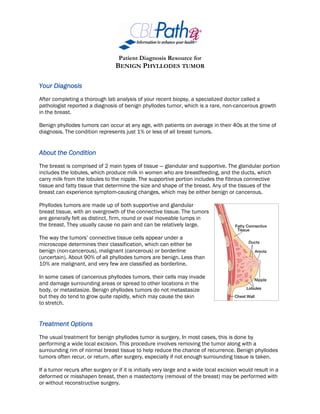
Benign phyllodes tumor
- 1. Your Diagnosis After completing a thorough lab analysis of your recent biopsy, a specialized doctor called a pathologist reported a diagnosis of benign phyllodes tumor, which is a rare, non-cancerous growth in the breast. Benign phyllodes tumors can occur at any age, with patients on average in their 40s at the time of diagnosis. The condition represents just 1% or less of all breast tumors. About the Condition The breast is comprised of 2 main types of tissue — glandular and supportive. The glandular portion includes the lobules, which produce milk in women who are breastfeeding, and the ducts, which carry milk from the lobules to the nipple. The supportive portion includes the fibrous connective tissue and fatty tissue that determine the size and shape of the breast. Any of the tissues of the breast can experience symptom-causing changes, which may be either benign or cancerous. Phyllodes tumors are made up of both supportive and glandular breast tissue, with an overgrowth of the connective tissue. The tumors are generally felt as distinct, firm, round or oval moveable lumps in the breast. They usually cause no pain and can be relatively large. The way the tumors’ connective tissue cells appear under a microscope determines their classification, which can either be benign (non-cancerous), malignant (cancerous) or borderline (uncertain). About 90% of all phyllodes tumors are benign. Less than 10% are malignant, and very few are classified as borderline. In some cases of cancerous phyllodes tumors, their cells may invade and damage surrounding areas or spread to other locations in the body, or metastasize. Benign phyllodes tumors do not metastasize but they do tend to grow quite rapidly, which may cause the skin to stretch. Treatment Options The usual treatment for benign phyllodes tumor is surgery. In most cases, this is done by performing a wide local excision. This procedure involves removing the tumor along with a surrounding rim of normal breast tissue to help reduce the chance of recurrence. Benign phyllodes tumors often recur, or return, after surgery, especially if not enough surrounding tissue is taken. If a tumor recurs after surgery or if it is initially very large and a wide local excision would result in a deformed or misshapen breast, then a mastectomy (removal of the breast) may be performed with or without reconstructive surgery. Patient Diagnosis Resource for BENIGN PHYLLODES TUMOR
- 2. Because of the possibility of recurrence, benign phyllodes tumor patients should be closely followed after surgery, having frequent clinical breast exams and imaging tests. According to the American Cancer Society (ACS) general recommendations for early breast cancer detection, women in their 20s and 30s should have a clinical breast exam by a health professional as part of their regular health exams, preferably every 3 years. The ACS recommends that women age 40 and older have a mammogram and a clinical breast exam each year. What You Can Do Steps you can take to maximize your health and reduce the risk of developing breast or other types of cancer include: ♦ Burning up all of the calories you take in each day through healthy eating and regular exercise ♦ Minimizing stress by getting enough sleep every night and using relaxation techniques ♦ Cutting out the use of tobacco and limiting your alcohol consumption ♦ Visiting your doctor regularly and promptly reporting any breast changes or new symptoms that develop You can also perform a breast self-exam once a month, which has been shown to play a small role in finding breast cancer and is recommended by the ACS for women age 20 and older. These exams help you know how your breasts look and feel normally, so you can more easily notice any unusual changes and report them promptly to your doctor. Talk with your doctor about the best techniques to use during breast self-exam, or visit the American Cancer Society and Susan G. Komen Websites listed below for more details. Additional Resources American Cancer Society, 800.227.2345, www.cancer.org National Cancer Institute, 800.422.6237, www.cancer.gov Susan G. Komen Breast Cancer Foundation, 800.462.9273, www.komen.org This patient resource sheet is provided to you as a service of CBLPath® and is intended for information purposes only. It is not meant to serve as medical advice or a substitute for professional medical care. Treatment options may vary, and only you and your physician can determine your best treatment plan. © 2008 CBLPath, Inc.
